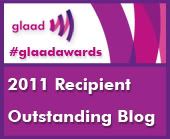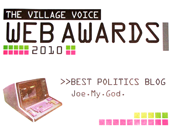A Response From The AIDS Quilt Director
Last weekend, my houseguest was my former boss, Jerry Suarez, his visit coincidentally beginning just a couple of days after I'd blogged about him in my post regarding the New York Times article about the AIDS Quilt. Jerry has been associated with the Quilt for almost 20 years now, starting in Miami as a panel maker for his father and brother, then as head of the Florida chapter of the NAMES Project.
Today Jerry lives in Los Angeles and is on the national board of directors for the AIDS Quilt. Before Jerry's suitcase had even hit my living room floor, he had Julie Rhoad, the executive director of the NAMES Project on the phone with me. Julie and I has a nice chat about the Times article, some misperceptions that she felt it may have caused, and the current successes and challenges for the Quilt and its dedicated workers. Below is her passionate letter to the readers of this blog. Please read it. And please consider making your own donation to the AIDS Quilt.
JMG: My heartful thanks go out to Julie Rhoad, Jerry Suarez, and all of the dedicated employees and volunteers of the NAMES Project/AIDS Memorial Quilt.Dear Joe.My.God readers:
I want to thank you all who have responded to Joe's blog regarding The AIDS Memorial Quilt. Your passion is evident in your responses, and the amount of interest the topic generated serves to discount the assertion that The Quilt may have "lost its punch."
And Joe, to your point, I understand that you relayed an interpretation of the Times article in which Jesse McKinley did speculate that perhaps The Quilt is less effective than it once was. The reality is that the suggestion that The Quilt has been either languishing or rotting on the shelves in Atlanta couldn't be further from the truth. If you measure the success of the organization by our display activity then here are some facts:
-In the years since our move, display activity across the country has increased by more than 80%.-In each of the last three years, more than half of the nearly 6,000 12 x 12 foot sections of the Quilt have been on display in venues throughout the United States, including notable venues like the United Nations, the Library of Congress and hundreds of equally important venues: high schools, middle schools, faith institutions, corporations, government centers and more.
-The tremendous growth in our display activity has increased our ability to provide high schools, middle schools and faith-based institutions with the Quilt for little or no charge, as a result, display activities in those areas have increased by more than 300% since the move.
In reading the string of responses, I heard a couple of concerns and opinions about conservation, archiving, digitizing, and using The Quilt to educate and inform audiences today as well as future generations. The work we have put into securing The Quilt and its Archive directly serves our mission and will help us expand our efforts to obtain the kind of support we will need to make digitization plans a reality.This is a massive undertaking and it will take years to accomplish, however, the first crucial step has been taken, we secured the designation as an American Treasure - a nationally significant, cultural, folk-art collection that is an important component of our culture and heritage that helps to explain America's past to future generations.
So why have we been silent, or rather quiet about our accomplishments? In part, because we were silenced by the lawsuit filed against the agency, and in part because this administration inherited a significant amount of debt in 2001 (that had been pushed forward for years), along with a crumbling infrastructure to try and restore. Our efforts were first and foremost dedicated to rebuilding our core program activities: displaying the Quilt, caring for the Quilt and the archive, caring for panel makers new and old, and in general, rebuilding the agency.We have succeeded in many areas. We have chipped away, but not retired the debt. (It probably goes without saying that it's very difficult to fundraise when you have debt and when you are being sued.) The records demonstrate that we have revitalized the display program, and according to Gert McMullin (our production manager and conservator), the Quilt itself is in the best physical shape it has been in since the early years.
As you consider the state of The Quilt and your perceptions of its value in today's society, I ask you to recognize that with the founding of The Quilt, The NAMES Project fostered the creation of visual testimony evidence that offered solace to the grieving and helped give voice to AIDS activism. By caring for and organizing thousands of displays, The NAMES Project and its volunteers and partners have transformed the narratives of remembrance into a provocative cultural record that is one of the most potent HIV prevention and educational teaching tools in existence.Today the Quilt is viewed as the social intersection of understanding - the fabric of the panels reflects more than the individual stories of the men, women, and children lost. When presented and analyzed as a collection, the panels truly serve as a mirror reflecting our society's struggles, responses, and attitudes toward the most complex human disease epidemic of modern history.
In closing, I would like to reiterate my sincere appreciation for the passion you have expressed for The Quilt. I share your concerns and am more than willing to talk about The NAMES Project and The Quilt whenever invited to do so. I encourage you to visit us, host a display, make a panel or help someone who is struggling with their grief. And of course I encourage you to donate to The NAMES Project. We are rich in many ways, but sadly, we lack adequate funding.
Julie Rhoad
Executive Director
The NAMES Project/AIDS Memorial Quilt
.
Labels: AIDS Quilt, gay culture










